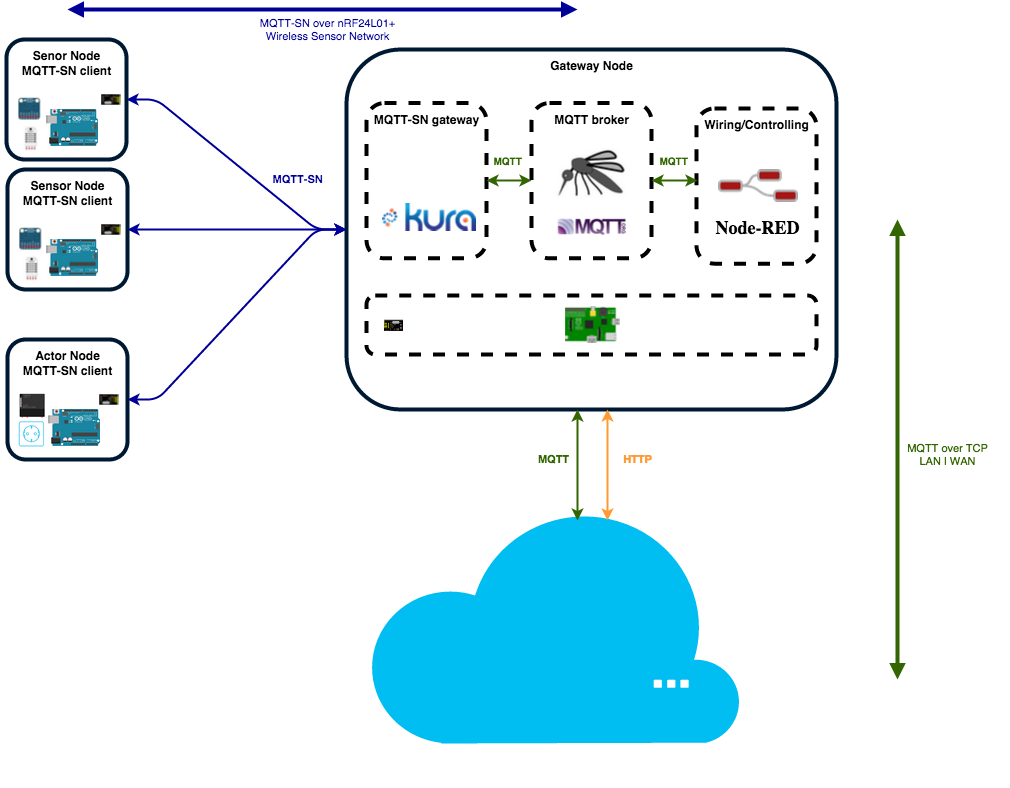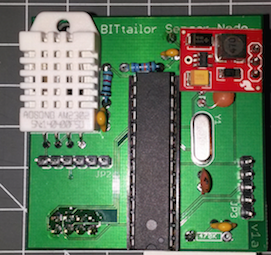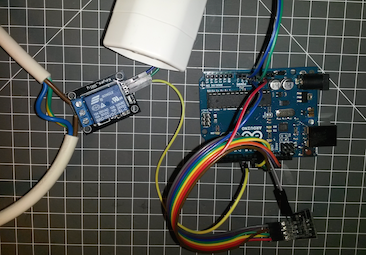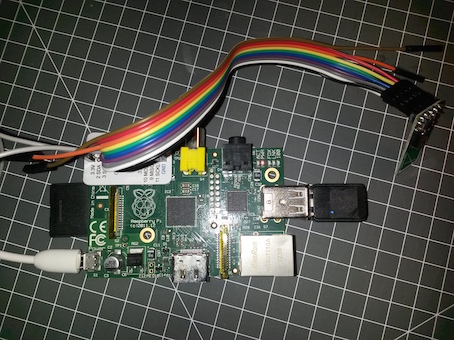Project Wrap-Up
Creating a maker friendly DIY IoT home automation solution
This is the final wrap-up post for my Eclipse Open IoT Challenge project. I set out to build a maker friendly DIY IoT home automation solution, driven by my dissatisfaction with the humidifier control plugs I owned.
So as a proof of concept for my maker friendly DIY IoT home automation solution I built a simple IoT air humidifier:
Overview

This shows the overview of what I built which is nearly the same picture as in my project idea post. I did not manage to build and setup everything I had in mind. Due to lack of time I skipped the connection to the various cloud services but I think it is simple to set them up trough configuring bridges on the Mosquitto broker or creating some forwarding flows in Node-RED.
All the source code for my project can be found on
But now to the details of what I built:
The sensor node
Hardware


For the sensor node I created its own PCB that connects:
- the ATmega328 with the 8MHz crystal oscillator
- the nRF24L01+ transceiver module
- a DHT22 temperature and humidity sensor
- a BMP085 barometric pressure and altitude sensor
- a battery holder for 2 AAA batteries
- a NCP1402 3.3V Step-Up power converter
- and a simple voltage divider to monitor the battery level
Software
The sensor node software is built with the Arduino programming platform. Besides the Arduino UNO core it uses the following libarries:
- DHTLib to read the DHT22 temperature and humidity sensor.
- uA a low power library for Arduino to enable sleeping on the sensor node.
- BtMqttSn my library for a MQTT-SN client communicating over a nRF24L01+ Transceiver.
The code of the sensor node is here. It publishes regularly the temperature and humidity with MQTT-SN over the wireless sensor network.
The actor node
Hardware

The actor node is currently just built as a prototype using a relay connected to an Arduino Uno board to switch a power line. The nRF24L01+ is used to communicate over the wireless sensor network.
Software
Also the sensor node software is built with the Arduino programming platform. The code of the actor node is here. It uses MQTT-SN over the wireless sensor network to subscribes to a topic to control the relay.
The gateway
Hardware

The gateway is built with a Raspberry Pi. The nRF24L01+ transceiver module is connected trough SPI.
Software
There are three main services on the gateway:
The MQTT-SN gateway
This is the application I built with the Kura framework. It gateways the MQTT-SN messages of the wireless sensor network to MQTT messages forwarded to the MQTT broker. The gateway is made up of three OSGI bundles:
- ch.bittailor.iot.core Contains the implementation of the nRF24L01+ based wireless sensor network and the MQTT-SN gateway using the wireless sensor network.
- ch.bittailor.iot.wsn Provides the wireless sensor network packet socket as OSGI service.
- ch.bittailor.iot.mqttsn Provides the MQTT-SN gateway as OSGI service.
I planned to build a transparent gateway but since the Kura CloudClient already provides an aggregating MQTT service it is an aggregating gateway now.
The gateway currently supports:
- Publish and subscribe with QoS 0.
- Sleeping clients.
It does not yet provide:
- QoS 1 und QoS 2.
- The search gateway feature, since the wireless sensor network does not yet provide a broadcasting.
- The last will feature.
Furhter the wireless sensor network limits the maximum length of a MQTT-SN message to 29 octets.
The MQTT broker
Here I just installed the Mosquitto broker.
Node-RED
Installed node.js on the Raspberry Pi and then Node-RED via npm.
The wireless sensor network
The wireless sensor network is built with the nRF24L01+ transceiver modules. The transceiver provides a link layer that features automatic acknowledgement and retransmissions of packets. On top of this a tree based network layer, where each node has one parent and five child nodes, is implemented on the nodes and on the gateway. No fragmentation and reassembly is implemented in the network layers. Currently broadcasting and encryption are not implemented yet.
Lessons learned and conclusion
As always I completely underestimated the time I need to implement my ideas. I spent quite some time on understanding or fighting with Tycho and the hole build chain while working with Kura. It was nice that the Kura forum helped me with the (sometimes strange) questions I asked. I could even give a little bit back to the Kura community by my pull request that got meregd to Kura and fixed the SPI jdk.dio.policy.
I think the Kura framework provides a good platform to implement the MQTT-SN gateway. My MQTT-SN gateway is still in a prototype stage and missing some features. It is also too tightly coupled to my wireless sensor network implementation. I think this coupling could be removed and generalized so that other networks like UDP or ZigBee could be plugged in.
I choose to implement my own wireless sensor network based on the nRF24L01+ transceiver modules because they are very inexpensive, are low power and I had a lot of them laying around. I’m not sure that it is the right way to continue, since it puts quite a burden on the sensor nodes to implement the network layer and it is still lacking some important features like encryption, broadcasting, fragmentation and reassembly.
I hope somebody enjoyed reading my posts. I for sure enjoyed working on my Eclipse Open IoT Challenge project and I’m still eager to further play with IoT.